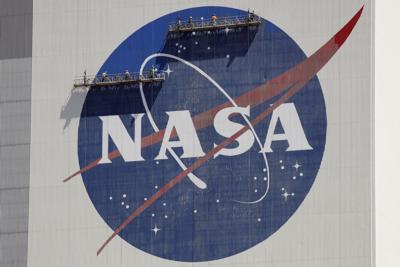Intelligent alien life is likely to exist somewhere in the universe, NASA boss Bill Nelson has said.
CAPE CANAVERAL, Fla. (AP) — NASA is launching a study of UFOs as part of a new push toward high-risk, high-impact science.
The space agency announced Thursday that it's setting up an independent team to see how much information is publicly available on the matter and how much more is needed to understand unexplained sightings. The experts will also consider how best to use all this information in the future.
NASA's science mission chief, Thomas Zurbuchen, acknowledged the traditional scientific community may see NASA as "kind of selling out" by venturing into the controversial topic, but he strongly disagrees.
"We are not shying away from reputational risk," Zurbuchen said during a National Academy of Sciences webcast. "Our strong belief is that the biggest challenge of these phenomena is that it's a data-poor field."
People are also reading…

Workers on scaffolding repaint a NASA logo at the Kennedy Space Center in Cape Canaveral, Fla., on May 20, 2020.
NASA considers this a first step in trying to explain mysterious sightings in the sky known as UAPs, or unidentified aerial phenomena.
The study will begin this fall and last nine months, costing no more than $100,000. It will be entirely open, with no classified military data used.
NASA said the team will be led by astrophysicist David Spergel, president of the Simons Foundation for advancing scientific research. In a news conference, Spergel said the only preconceived notion going into the study is that the UAPs will likely have multiple explanations.
"We have to approach all these questions with a sense of humility," Spergel said. "I spent most of my career as a cosmologist. I can tell you we don't know what makes up 95% of the universe. So there are things we don't understand."
___
The Associated Press Health and Science Department receives support from the Howard Hughes Medical Institute's Department of Science Education. The AP is solely responsible for all content.
50 images of the universe from the Hubble Space Telescope
50 images of the universe from the Hubble Space Telescope

On April 24, 1990, the Space Shuttle Discovery launched, carrying the Hubble Space Telescope (HST, or just "Hubble"). This orbiting telescope was the first of NASA's Great Observatories. For more than 30 years, HST has provided astronomers with incredible scientific data on everything from solar system objects to some of the most distant galaxies in the cosmos. Hubble was named for American astronomer Edwin Hubble, who in the early 20th century helped establish that the universe is much bigger than the Milky Way and showed the cosmos is expanding.
Stacker collected 50 Hubble images, taken between 1990 and 2020, that express both the beauty of the universe and important scientific knowledge. HST is a bus-sized satellite containing a 2.4-meter-diameter mirror for focusing light from distant objects, along with a suite of instruments for photography, measuring light intensity, and taking the spectrum of various astronomical sources. Hubble is primarily an optical telescope, viewing the cosmos in the same type of light we can see, and it also has the ability to see into the infrared and ultraviolet parts of the spectrum of light. The size of the telescope and its location above Earth's atmosphere (with its pesky weather and distortions from air currents) make HST one of the best optical telescopes still in operation.
HST is jointly operated by NASA and the European Space Agency and was designed to be serviced by astronauts. Unfortunately, the Hubble needed to be repaired immediately after launch, when it turned out its mirror was slightly flawed. NASA astronauts installed additional mirrors to compensate for the flaws in 1993 and upgraded other scientific instruments on five different occasions, with the last upgrade being in 2009. Meanwhile, no plans are in the works to build an equivalent space telescope, so astronomers and nonscientists alike hope Hubble will continue to work indefinitely.
Click on for 50 images of the universe as seen from the Hubble Space Telescope.
You may also like: Space discoveries that will blow your mind

The Pillars of Creation (1995)

Perhaps Hubble's most popular image involves part of the Eagle Nebula known as the "Pillars of Creation." The Eagle Nebula is a star-forming region of the Milky Way, which means a cold cloud of gas and dust dense enough for gravity to take hold and collapse material into new stars. Ultraviolet light from these newborn stars erodes the nebula away, leaving the beautifully sculpted pillars in the image.
The Eagle Nebula in Infrared (2015)

The dense gas and dust of the Eagle Nebula are opaque in visible light but transparent to infrared. Hubble's infrared vision of the Pillars of Creation reveals they are harboring additional baby stars swaddled in gas.
Prelude to a Cosmic Explosion (1995)

In the early 1800s, the unremarkable star Eta Carinae in the southern constellation Carina grew suddenly brighter, briefly becoming the second-brightest star in the entire sky before fading. Later observations, including the one that produced this famous Hubble image, showed that Eta Carinae is actually two very massive stars shedding matter in two huge lobes of gas. Astronomers think these stars are unstable and will eventually explode in a supernova.
The Giant Next Door (2015)

Andromeda Galaxy (also known as M31) is the closest large galaxy to our Milky Way, near enough for astronomers to distinguish individual stars. This Hubble mosaic of a portion of Andromeda is the biggest image the telescope has made (constructed of 7,398 individual exposures!), containing over 100 million visible stars. Like the Milky Way, M31 is a spiral galaxy, with many of its brightest stars clustered in arms winding out from the galactic center.
The King of Planets (2017)

While much of Hubble's greatest work involves distant stars and galaxies, the observatory has also provided a wealth of information about our solar system. This 2017 image of Jupiter is part of an HST program to chart changes in the atmospheres of the giant outer planets. In particular, astronomers are watching the way Jupiter's famous Great Red Spot (known since the time of Galileo) is shrinking.
You may also like: The best streaming services in 2021
Jupiter's Auroras (2016)

Auroras are caused when electrically charged particles cascade into a planet's atmosphere. On Earth, these are the northern and southern lights visible at high latitudes; Jupiter, being a much bigger planet with a huge magnetic field, has proportionally larger auroras. Hubble captured Jupiter's auroras using its ultraviolet instrument, and this picture was constructed by overlaying the UV image over a visible-light photo.
Galaxies in Collision (2010)

The Antennae Galaxies are a pair of galaxies in the process of colliding, a slow process taking hundreds of millions of years. This picture combines images from NASA's Great Observatories—Hubble (visible light), the Spitzer Infrared Observatory (infrared), and the Chandra X-ray Observatory (X-rays)—highlighting how these premiere space telescopes work together. The collision between the galaxies is producing new stars at a fast rate.
It's Full of Galaxies (1996)

In 1996, astronomers pointed HST at a small unremarkable spot on the sky nearly empty of stars and took pictures for 10 days to get a clear view deep into the cosmos. The 342 photos assembled from the project make up the Hubble Deep Field Survey and contain roughly 3,000 individual galaxies, some billions of light-years away. In fact, nearly everything you see in this image is a galaxy, revealing the diversity and evolution of galaxies over the history of the universe.
Echoes from an Explosion (2010)

In early 1987, astronomers spotted a new bright point of light in the nearby galaxy in the Large Magellanic Cloud: Supernova 1987A, the explosion of a massive star. Because it is the closest supernova in modern times, astronomers have been able to track the aftereffects of the explosion. This 2010 Hubble image shows expanding bubbles of matter blasted away from the dying star, producing beads of light where the material slammed into clumps of gas in the surrounding region.
The First Image of Another Star (1996)

Despite the power of modern telescopes like HST, most stars other than the sun are too far away to be anything but points of light. However, Hubble captured the first details on another star in 1996: the red giant Betelgeuse, which is part of the constellation Orion. As the diagram shows, Betelgeuse is so huge it's no longer spherical; in 2020, material ejected from the star blocked enough of its light that it dimmed visibly.
You may also like: History of famous firsts in space
Seeing With Gravity's Telescope (2018)

Galaxy clusters are the largest objects in the universe held together by gravity and can consist of thousands of individual galaxies. Abel 370 has so much mass (mostly in the form of mysterious invisible dark matter) that its gravity focuses light from more distant galaxies, producing magnified and distorted images of objects too far to be seen ordinarily. You can see some of those magnified galaxies in this HST image, appearing as smeared arcs of light.
Five Moons for Tiny Pluto (2012)

Before the New Horizons probe arrived on Pluto in 2015, astronomers turned HST to the dwarf planet to look for any potential hazards. This 2012 image shows Pluto's five moons, including a fifth previously unknown moon, now known as Styx. Hubble was also used to discover the moons Nix, Hydra, and Kerberos, which are too small to be seen with less powerful telescopes.
A Dying Star and an Hourglass (1996)

Smaller stars like our sun don't explode as supernovas but shed material as they die. Some of these form "planetary nebulas" like the Hourglass Nebula, which forms two interlinked bubbles of gas. The eerie effect here is because Hubble doesn't "see" color the way people do, so the image colors (and many other images in this slideshow) correspond to the presence of particular types of atoms or molecules: green for hydrogen, red for nitrogen, and blue for ionized oxygen.
The Horsehead Nebula in Infrared (2013)

The Horsehead Nebula in the constellation of Orion is one of the most popular objects to look at through backyard telescopes, where it looks like a horse-shaped shadow against background stars. This HST infrared image shows newborn stars hiding inside the billowing nebula gas. Like the Eagle Nebula, the Horsehead is being eroded by ultraviolet light from nearby young, hot stars.
A Jet from a Black Hole (2010)

M87 is a giant elliptical galaxy (meaning: it has mostly old stars and no spiral arms) in the Virgo Cluster of galaxies. Like nearly every galaxy we know of, M87 harbors a huge black hole near its center, which was imaged by the Event Horizon Telescope in 2019. This set of HST pictures shows a jet of matter blasted out by that black hole, stretching out farther than the visible edges of M87.
You may also like: The best streaming services for sports in 2021
The Colorful Crab (2020)

The Crab Nebula is the remains of a star that went supernova and which was observed across the world in 1054 C.E. This image combines optical light from Hubble (in yellow), infrared light from Spitzer (in red), and X-ray light from Chandra (in blue), revealing the complex internal structure of this centuries-old supernova remnant. Matter continues to collide inside the nebula even after all this time, explaining the tendrils and bubbles you see in the picture.
A Flickering Cosmic Candle (2013)

RS Puppis is a star known as a Cepheid variable: aging stars that pulsate, with predictable fluctuations in their light. This southern hemisphere star pulsates roughly every six weeks, creating "light echoes" in the surrounding gas. Early 20th-century astronomer Henrietta Swan Leavitt discovered that Cepheid variables have a connection between the frequency of fluctuations and their brightness, which allowed Edwin Hubble to make the first measurement of the distance to Andromeda Galaxy.
Saturn's Rings and Hexagon (2019)

As part of the giant planet monitoring program, HST captured this beautiful image of Saturn. Not only are the planet's famous rings shown clearly, but you can also see the hexagonal storm at Saturn's north pole, a feature not identified before the Cassini spacecraft mission.
Northern and Southern Lights, Saturn Style (2010)

Earth's seasons are caused by the fact that our axis is tilted, so the north pole points toward the sun in the summer and away in winter. Saturn has an even stronger axial tilt, but Hubble captured this ultraviolet image near the planet's equinox so that both poles were nearly in view at once. That allows us to see the auroras—northern and southern lights—in a single image, a rare occurrence.
A Supernova in the Galactic Outskirts (1999)

The bright star-light object toward the lower-left corner of this image is Supernova 1994D, on the outskirts of the galaxy NGC 4526. It's a Type Ia supernova, which is the explosion of a white dwarf (the remnant of the core of a star like our sun). Astronomers use Type Ia supernovas to measure the expansion of the universe because they're bright enough to be seen from billions of light-years away.
You may also like: 50 space terms for understanding the universe
A Galactic Whirlpool (2005)

The Whirlpool Galaxy (M51) is a favorite galaxy for many people, and this Hubble image shows why. As a "grand design" spiral galaxy, the spiral arms are clearly defined, dotted with bright young blue stars and pink clouds where new stars are forming. Gravitational interactions with the smaller galaxy likely drive this star formation at the right side of the image.
A Ring of Bright Matter (2013)

The Ring Nebula is a planetary nebula, the shedded material from a dying sun-like star. We see this system from an angle that shows the ring structure, but this 2013 HST image reveals the blue part of the nebula is an oblong bubble that passes through the ring. At the Ring Nebula's very center, you can make out a white dot that is a white dwarf, the remnant of the original star's core.
Gonggong and Xiangliu

The two largest known objects beyond Neptune in our solar system are Eris and Pluto; the third-largest is Gonggong, discovered in 2007 and finally named in 2019. These HST images show how astronomers discovered its moon Xiangliu by comparing archival pictures and looking for how things changed. Gonggong, like other distant solar system worlds, is too small to be anything but a pinpoint of light in most telescopes, requiring observatories of Hubble's caliber.
What's Deeper than Deep? Ultra Deep (2004)

Following up on the earlier Hubble Deep Field Survey, astronomers upped the ante and conducted the Hubble Ultra Deep Field Survey, looking at one relatively empty patch of the sky for roughly 1 million seconds (nearly 12 full days). This longer exposure revealed 10,000 galaxies, including some of the most distant yet discovered.
The Invisible Made Visible (2009)

The Bullet Cluster is actually two galaxy clusters caught in the act of collision, where the "bullet" is a shockwave in X-ray emitting hot gas (from Chandra, shown in red). The visible light Hubble data allowed astronomers to measure where the mass from each cluster was concentrated (shown in blue). They found most of that mass was separated from the hot gas, meaning it's made up of invisible matter; this is one of the best direct measurements of the mysterious dark matter that makes up most of the matter in the cosmos.
You may also like: 32 groundbreaking NASA missions in photographs
Neptune's Dark Spot (2019)

The Voyager 2 spacecraft provided us with our first images of Neptune with its 1989 flyby, showing, in particular, a large dark-colored storm on the planet's blue disk. Later Hubble pictures didn't show this Great Dark Spot, meaning the storm had dissipated. However, a new Great Dark Spot formed in a different place on Neptune, as seen in this image; this behavior shows how huge storms form and break up on giant worlds.
Gravity Makes You See Quadruple (2020)

Quasars are supermassive black holes that heat up matter until it glows brightly. In these HST pictures, gravity from a foreground galaxy focuses and splits light from more distant quasars, making one quasar look like four. This effect is known as strong gravitational lensing, and astronomers use it to measure how far those quasars are from Earth by timing when each image flickers.
The Southern Pinwheel Galaxy (2014)

The Southern Pinwheel Galaxy (M83) is a "flocculent" spiral galaxy, meaning its spiral arms look fleecy thanks to the copious amounts of gas and dust they contain. This high-resolution image of M83 reveals the processes of star formation and cavities where stars exploded in supernovas.
A Stellar Shockwave (2002)

The Great Nebula of Orion is a star-forming nebula that can be seen on a dark night without a telescope in Orion's "sword." A young hot star in that nebula, LL Ori, is pumping out streams of charged particles known as stellar wind at speeds high enough to produce a shockwave in the surrounding gas. Though we can't see the whole thing, this shockwave surrounds the star, though not in a spherical shape.
A Cosmic Penguin (2013)

The two galaxies making up the object Arp 142 collided, their mutual gravity pulling one of the galaxies into a shape resembling a galactic penguin. This penguin was once a spiral galaxy like ours, but the encounter has disrupted its shape and driven the production of new stars. The second object is an elliptical galaxy, which consists of older stars and little gas, which may be why its shape hasn't been roughed up as much by the collision.
You may also like: U.S. Army history from the year you were born
Snapshots of Infant Star Systems (2006)

These two images show disks of dust and ice around newborn stars, which are thought to resemble the Kuiper Belt in the outer part of our own solar system. These protoplanetary disks, as they are called, form from the leftovers of the host star's birth. In these cases, there might be planets orbiting closer in, but even Hubble's capabilities aren't good enough to see something so relatively tiny.
Ancient Stellar Jewels (2015)

Globular clusters are roughly spherical collections of tens of thousands of stars, including some of the oldest stars we know of. The cluster 47 Tucanae (located in the southern constellation Tucan) is part of the Milky Way but is older than our galaxy by several billion years.
The Tarantula Nebula in Infrared (2014)

The Large Magellanic Cloud is the largest satellite galaxy of the Milky Way, and home to Supernova 1987A. It's also home to the huge star-forming region known as the Tarantula Nebula. Hubble's infrared camera revealed a staggering 800,000 stars and protostars inside the Tarantula, of which you can see more than a few in this image.
An Inbound Comet (2017)

The comet C/2017 K2 PANSTARRS (or more simply K2) was first seen by Hubble in 2017 when it was past the orbit of Saturn. Comets are made of rock and ices (including water ice, carbon dioxide ice, and others) that form the distinctive tails when heated by the Sun. Even at that distance, sunlight was enough to melt the outer layers of K2, making it the most distant active comet ever seen.
Our Next-Nearest Galactic Neighbor (2019)

The Milky Way is one of three large galaxies in the small cluster known as the Local Group. The other two are Andromeda (the biggest of the group) and Triangulum (M33), a small spiral. Despite the fact that it's probably as old as its larger neighbors, Triangulum is producing new stars at a fairly high rate, which intrigues astronomers.
You may also like: 50 famous paintings and the stories behind them
A Galactic Rose (2011)

Galaxy collisions may seem violent, but they're one major way small galaxies grow into bigger ones, as they merge together. And undoubtedly galactic collisions are beautiful, as in with the galaxies of Arp 273, which HST captured to commemorate its 21st anniversary. As with other examples of interacting galaxies we've seen, Arp 273 shows star formation spurred on by each galaxy's gravitational tug on the other.
A Cap of Clouds (2019)

When Voyager 2 visited Uranus in 1986, the pictures it returned to Earth showed a green-blue planet nearly unblemished by clouds. By contrast, this recent Hubble image shows a stormy cap of clouds over Uranus' pole. Since Uranus has the most extreme axial tilt of all planets—essentially tipped on its side—it also experiences the most extreme seasons, which may drive weather in ways we don't fully understand yet.
When the Same Supernova Happens More Than Once (2015)

Supernovas, by definition, only happen once, since when a star blows up, there's nothing left to explode again. However, using strong gravitational lensing, astronomers were able to witness Supernova Refsdal four times when light from the explosion passed near a foreground galaxy. This effectively quadrupled the data from the supernova, providing both extra information about the explosion and a way to test the modern theory of gravity in new ways.
Blowing Stellar Bubbles (2016)

All stars—our sun included—produce "wind" in the form of electrically charged particles blowing off the surface. The star at the center of the Bubble Nebula is 45 times more massive than the sun, and its wind has carved out a cavity in the surrounding gas seven light-years across. The nebula itself is the beautifully illuminated shape made where the wind collides with that gas.
A Supernova on the Face of a Spiral Galaxy (2018)

Spiral galaxy NGC 1015 has a striking appearance, in large part, because we see it almost perfectly "face on." The central part of the galaxy is marked by a bar of stars and gas, surrounded by a ring of matter. But this Hubble image also fortuitously includes Supernova 2009ig, a Type Ia supernova caused by the explosion of a white dwarf.
You may also like: Popular fashion trends the year you were born
The Red Rectangle Nebula (2004)

Most shapes in space are round or blobby, but the planetary nebula HD 44179 is boxy, giving it the popular name the Red Rectangle. This 2004 Hubble image shows that the fundamental shape of the matter being shed by a dying star is more like an X, which explains why the material looks rectangular from a distance.
A Moon for Makemake (2016)

Makemake is one of the dwarf planets in the outer solar system discovered within the past 20 years. Until 2015, astronomers couldn't tell if it had a satellite or not, but this Hubble image revealed a faint moon that might have been hiding in Makemake's glow previously. Named "S/2015 (136472) 1" and nicknamed "MK 2," the moon's presence helps astronomers measure important properties about Makemake, such as its mass.
Yeeting a Star From the Galaxy

This picture of a star looks downright mundane until you realize it's speeding out of our galaxy at a breakneck 1.6 million miles per hour. HE 0437-5439 is known as a "hypervelocity" star, and it was likely part of a multiple-star system that drifted too close to the Milky Way's supermassive black hole. The dance of gravity stripped HE 0437-5439 from its companions and kicked it out of the galaxy entirely.
The Sombrero Galaxy (2003)

The Sombrero Galaxy (M104) is another of Hubble's greatest hits, thanks to its very bright disk surrounded by a ring of dust. Because we see the galaxy nearly edge-on, it's hard to distinguish a lot of its features. However, astronomers have used this Hubble image to identify 2,000 globular clusters of stars in and around the galaxy.
A Dusty Red Planet (2018)

Mars can feel downright mundane compared to many of the other cosmic objects in Hubble's catalog, but astronomers have turned the telescope to look at our planetary neighbor many times in the past 30 years. This 2018 image shows the Red Planet with a winter cap of clouds over the north pole. You can also see Mars' two small potato-like moons, Phobos and Deimos, in the right and lower side of the photo, respectively.
You may also like: States doing the most for a clean energy future
A Deceptive Grouping (2009)

At first look, Stephan's Quintet seems to be five galaxies in collision. However, it turns out only three are actually interacting, and the bright galaxy in the upper left corner is seven times closer to Earth than the others. This optical illusion highlights the fact that occasionally things can look close together when they're actually very far apart, despite space being very big and mostly empty.
The Beauty of a Dying Star (2004)

The Cat's-Eye Nebula may be another planetary nebula, but each star like our sun seems to die in its own beautiful and spectacular fashion. This nebula, in particular, is strikingly complex, with concentric layers of shed material overlapping bubbles and an almost spiral-arm structure.
A Breathtakingly Distant Galaxy (2016)

Galaxy GN-z11 just looks like a red blob in this HST image, but that's because it's a breathtaking 13.4 billion light-years away. Since the universe is only about 13.8 billion years old, this means GN-z11 formed about as early as any galaxy can exist. In fact, it was very bright blue 13.4 billion years ago, but as the light from it traveled, it got stretched into the red part of the spectrum, a phenomenon known as cosmic redshifting.
A Most Peculiar Star (2004)

The star V838 Monocerotis (in the constellation Monoceros, or the Unicorn) brightened suddenly in 2002, then faded. Astronomers turned to HST to look at it and found an expanding shell of gas around the star. This image shows a Firefox-like swirl of material shed by the star, which was probably left over from an earlier outburst.
Hubble's Legacy (2019)

In 2019, Hubble astronomers collected 7,500 images taken over 16 years of observations to make the Hubble Legacy Survey. This mosaic includes infrared, optical, and ultraviolet data to provide a view of the cosmos, both deep and wide. With 265,000 galaxies in the field, you could spend your life looking at it and still find new things to discover, a worthy summation of Hubble's 30-year career so far.
You may also like: The best streaming services for football in 2021












